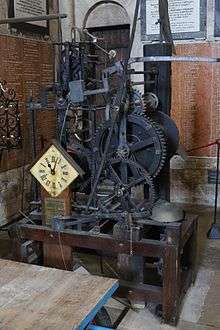Exeter Cathedral astronomical clock


The Exeter Cathedral Astronomical Clock is a fifteenth-century astronomical clock in Exeter Cathedral, England.
History and description
The clock is thought to date from around 1484.[1]
The outermost disc is decorated with a fleur-de-lis which represents the sun, and which orbits the dial once every 24 hours. This indicates the hour of the day, counted from I to XII in Roman numerals in first the right and then the left hemispheres of the clockface. This is an example of a 24-hour analog dial. The tail of the sun's fleur-de-lis points to the day in the lunar month on the inner ring. The half-black, half-silver moon inside the lunar month ring rotates on its axis to show the correct phase of the moon. The earth is represented as a fixed golden ball in the centre of the dial. The Latin inscription "Pereunt et imputantur" below the main dial may be translated as "The hours pass and are reckoned to our account".
A small bell located behind the clock dial chimes the quarter-hours. On the hour, this is followed by the striking of the Peter Bell in the tower above.
In 1759 the smaller upper dial was added with a single hand to indicate the minutes.
The clock-room is behind the dial on the north wall of the transept, and still houses the clock mechanism. Access is via a doorway visible in the stone wall directly beneath the clock. Legend suggests that the round hole cut in the bottom of the door was for the cathedral cat to gain entry to keep the clock clear of mice and rats. The modern clock mechanism was installed in 1885 by Gillett & Bland of Croydon.
The clock was restored in 1910 by John James Hall FRAS.[2]
The clock is also reputed to be the source of the nursery rhyme Hickory Dickory Dock, probably inspired by the round hole in the door described above.[3]
References
| Wikimedia Commons has media related to Exeter Cathedral astronomical clock. |
- ↑ The Unofficial Guide to England. Stephen Brewer. John Wiley & Sons. 2007
- ↑ "England's Oldest Clock". Aberdeen Journal. Aberdeen. 27 August 1910. Retrieved 15 September 2015 – via British Newspaper Archive. (subscription required (help)).
- ↑ Cathedral Cats. Richard Surman. HarperCollins. 2004
Coordinates: 50°43′23″N 3°31′50″W / 50.723°N 3.5305°W